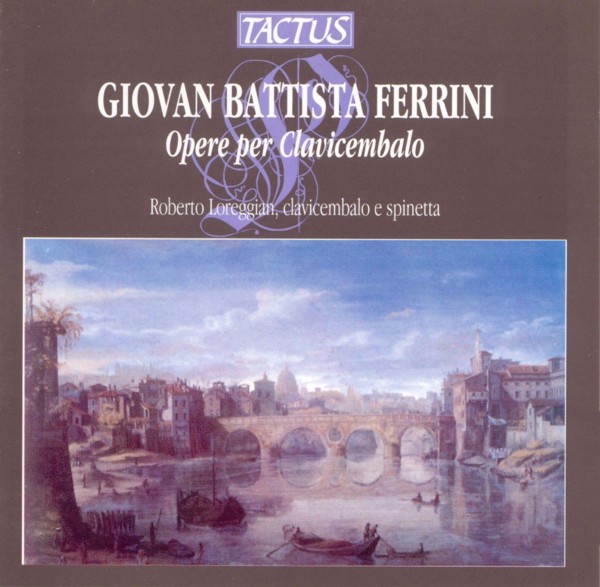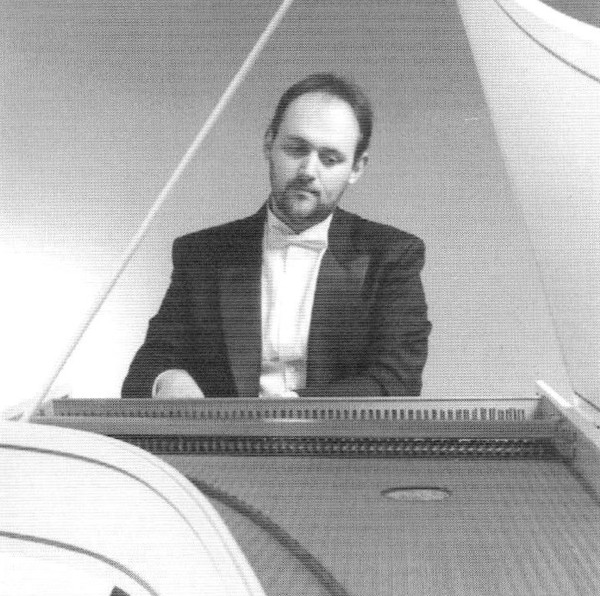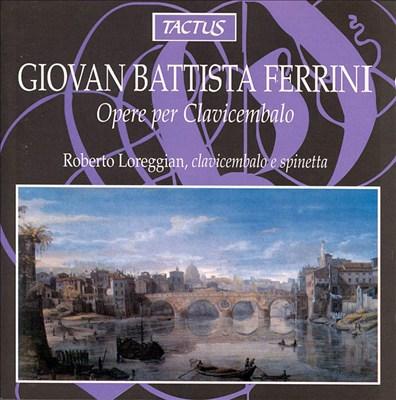Giovan Battista FERRINI. Opere per clavicembalo / Roberto Loreggian

Tactus TC 600601
febrero de 1996
Villa Beatrice, monte Gemola, Baone · Padova
01 - Tastata per clavicembalo [3:12]
02 - Ballo di Mantova Primo, Secondo, Terzo [2:58]
03 - Trombetta [3:34]
04 - Corrente [1:18]
05 - Rotta [0:57]
06 - Passagalli [1:57]
07 - Aria di Fiorenza Prima, Seconda,
Terza, Quarta [3:56]
08 - Corrente [1:27]
09 - Spagnoletta Prima, Spagnoletta Seconda [1:37]
10 - Ciaccone [1:15]
11 - Corrente [1:05]
12 - Passagalli [1:25]
13 - Balleto Primo, Balleto Secondo [1:49]
14 - Toccata [1:23]
15 - Corrente [1:07]
16 - Passagalli [2:55]
17 - Galiarda Prima, Galiarda Seconda [1:31]
18 - Toccata [6:32]
Dal manoscritto Chigi Q.IV.25 della Biblioteca Apostolica Vaticana
di scuola di Girolamo Frescobaldi (1583/1643)
19 - Toccata Prima [3:46]
20 - Capriccio fatto sopra il Cucchù [4:20]
21 - Toccata Seconda [4:48]
22 - Partite sopra l'Aria di Fiorenza [2:44]
23 - Toccata Terza [4:44]
Roberto Loreggian, clavicembalo
e spinetta
costruiti da Riccardo Pergolis

Giovan
Battista Ferrini, works for Harpsicord
Our knowledge of seventeenth-century Italian keyboard music is based
for the most part on the works of those few composers who were able at
the time to have their compositions printed. But many other composers
are mentioned in various other contemporary sources (literary,
theoretical or musical) about whom the official history of keyboard
music knows little or nothing. These musicians left nothing printed,
and often we know of them only from brief and scarce examples of their
art in the manuscripts of the so-called "tablatures" for harpsichord
and organ. Just such a figure is the Roman musician Giovan Battista
Ferrini (about 1601-1674).
Better known to his contemporaries as "Giovan Batista della spinetta",
Ferrini may be considered as one of the most interesting Italian
keyboard composers of the generation at work between Frescobaldi and
Bernardo Pasquini. Testifying to this are the numerous laudatory
references made to him by important musical theorists such as the
composer Romano Micheli, the famous Jesuit Athanasius Kircher in his Musurgia
universalis and Giuseppe Ottavio Pitoni in his Guida armonica.
He attained important positions during his career, as organist of two
of the most prestigious Roman churches of the time, S. Luigi dei
Francesi and S. Maria in Vallicella (Chiesa Nuova), and as occasional
collaborator for musical events in St. Peter's and S. Maria Maggiore.
But only in modern times has his importance been brought to light, and
only very recently have many uncertainties about his life been cleared
up. Giovan Battista Ferrini was born in Rome about 1601; his father was
a Florentine. In September 1619 he was named first organist of S. Luigi
dei Francesi, the French national church in Rome, after the death in
August of that year of the organist Pietro Speilier of Liège,
who had held the post for 27 years. It is improbable that such an
important post in one of the principal Roman churches would have been
trusted to a young man not yet 20 years old at the beginning of his
career. No doubt Ferrini was already known from his service in other
churches or, as often happened in Rome, he was probably a student of
his predecessor. He joined the list of illustrious names of maestri
di cappella (among others, G.B. Nanino, V. Ugolini, L. Ratti, 0,
Benevoli, S. Fabbri, A.M. Abbatini, E. Bernabei and A. Melani) which
inspired the composer Antonio Maria Abbatini to write, in a spirited
epistle in verse, that "it is said that the masters all come from S.
Luigi".
In September 1623 Ferrini left S. Luigi for a position of even greater
prestige: there can be no doubt that he went to S. Maria in Vallicella,
better known as the "Chiesa Nuova" (New Church). home of the famous
Congregation of the Oratory. Unfortunately, little remains in the
documents of his work at the New Church. In 1640 he requested to be
admitted to the Oratorians as "brother of the house", but was turned
down. In May 1653 he retired front his post and was assigned a monthly
pension of 2 scudi "to a person in need and who has honorably served
the congregation." He lived for many more years, comfortably, it seems,
thanks to this pension and an estate of 2 scudi per month he had
contracted for with the fathers of the Oratory in 1642. He died on
November 14, 1674, and was buried, as he requested in his will, at the
New Church.
Ferrini was evidently very well known; a large number of his
compositions for keyboard instruments were included in several
seventeenth-century Roman tablature collections for organ and
harpsichord. The main source for his compositions is the Vaticano
musicale 569 tablature in the Vatican Apostolic Library, from which
most of the pieces included in this recording have been taken. This
manuscript, made in the years 1661-1663, belonged to Virginio Muzi, a
doctor of law and amateur musician who had studied with Fabrizio
Fontana and also with a nephew and student of Ferrini's, Bonaventura
Mini. Except for a toccata expressly marked "for the organ", Ferrini's
keyboard compositions seem to have been mainly intended for the
harpsichord.
They may be divided into three genres: free-form improvisations such as
toccatas and tastate; dances, such as the four correnti
and the two gagliarde; and partitas on airs and bassi
typical of the keyboard repertoire of the time. Of this last type,
besides the usual Passagalli in various keys and Chaconnes, we
note the partitas on the Aria of Fiorenza, a ground bass
created by Emilio de' Cavalieri for the famous Florentine intermedi
of 1589, and the partitas on the Ballo of Mantua, a theme
which, as recently noted by Luigi Ferdinando Tagliavini, curiously runs
through Western music almost up to modern times, showing up in
Smetana's Moldava and even in the Israeli nation anthem. Particularly
remarkable for its rigourous form among the pieces presented here is
the Toccata in C, in three parts: the first two are
improvisational in character and present lively modulating progressions
and changes of rhythm, the third is of the imitative contrapuntal type,
built on a simple thematic element. The piece entitled Trombetta
is original in form, and is a playful piece on the theme of the famous
song "Girometta" heard in the middle of the composition, and on various
typical trumpet tunes set over a simple basso ostinato. Completing this
recording are several compositions taken from contemporary manuscripts.
Once attributed to Girolamo Frescobaldi, recent studies have reassigned
them more likely to the circle of musicians who were students of the
great master from Ferrara, The three toccatas, as well as the Partite
sopra l'aria di Fiorenza and the Capriccio sopra il cuccho,
demonstrate unmistakable formal and melodic similarities with
Frescobaldi's style.
Arnaldo Morelli
(translation: J. Baltrusaitis)



